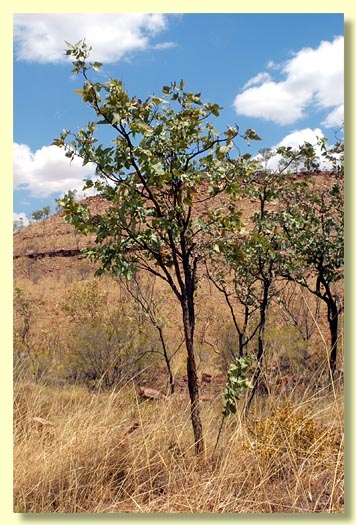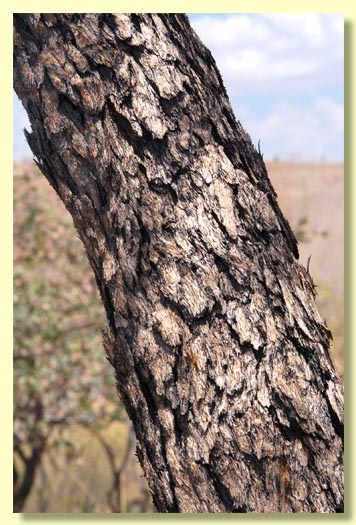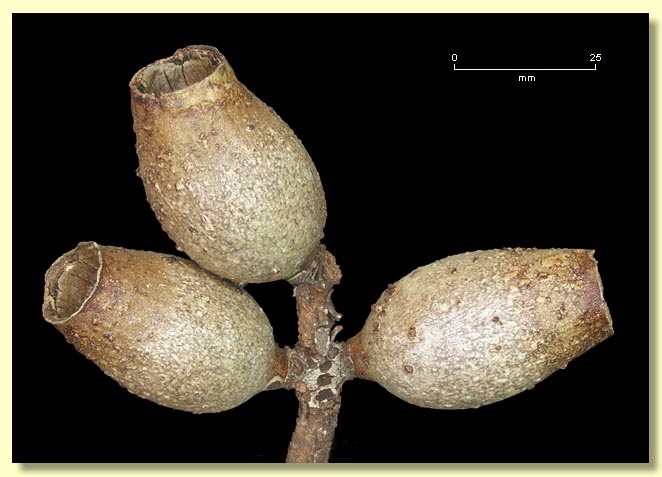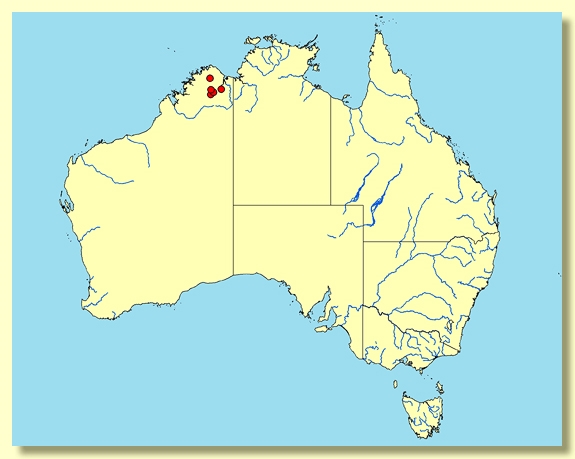Euclid - Online edition
Corymbia cadophora subsp. pliantha
Corymbia | Rufaria
Small tree to 6 m tall. Forming a lignotuber.
Bark rough to small branches, thick, ± corky, tessellated, grey-brown.
Branchlets lack oil glands in the pith; sometimes white due to opaque cuticle (not wax); new growth of leaves and branchlets initially setose, but the setae rapidly lost.
Juvenile growth (coppice or field seedlings to 50 cm): not seen.
Crown of juvenile leaves which are always opposite and sessile with the leaf-bases joined, thus encircling the stem; blade ovate to lanceolate, each leaf of the joined pair measuring 7–17.5 cm long, 2.8–7.8 cm wide, margin entire or slightly irregular, apex pointed or rounded, concolorous, dull, green to grey-green, smooth, side-veins at a wide angle to the midrib (penniveined), reticulation very dense, intramarginal vein present and close to the margin or confluent with the margin, oil glands apparently absent; setae sometimes present on midrib close to stem present and on new growth before leaf expansion..
Inflorescence terminal compound, large and well-branched, internodes and peduncles covered with short bristle-glands when very young, but when mature quite smooth, peduncles stout, rounded or angled, 0.5–3 cm long, buds (3)7(9) per umbel, with stoutly pedicellate or rarely sessile (pedicels 0–0.5 cm long). Mature buds obovoid to pyriform or ovoid (ca 1.3 cm long, 0.7 cm wide), reddish but sometimes also with a whitish cuticle, smooth, scar absent (both opercula shed together at flowering), operculum beaked, stamens inflexed, all fertile, anthers versatile, dorsifixed, oblong, dehiscing by longitudinal slits, style long and straight, stigma blunt and papillose, locules 3 or 4, with the vertical ovule rows indistinct on the placentae. Flowers (stamens) red to dark pink.
Fruit sessile or pedicellate (pedicels 0–0.4 cm long), urceolate to narrowly barrel-shaped, 2.5–3.6 cm long, 1.7–2.2(2.6) cm wide, longer than wide, neck not well developed, surface smooth, disc descending vertically, valves 3 or 4, enclosed.
Seeds brown, 10–17 mm long, ellipsoidal with terminal wing, hilum ventral.
Cultivated seedlings (measured at ca node 10): not grown.
Flowering has been recorded in August and September.
Corymbia cadophora is a small, straggly tree species endemic to the Kimberley region of Western Australia where found on sandstone and shaley slopes and outcrops, stony rises, sandy rises and sometimes on deeper loamy soils on rising ground. In this region this fully rough-barked species is easily distinguished from all other eucalypts by its coarse crown leaves that are always opposite and joined at the base, thus encircling the stem (connate or perfoliate), and the terminal inflorescences. C. cadophora was formerly incorrectly known as Eucalyptus perfoliata, a misapplied and illegitimate name.
There are three subspecies differing in features of the inflorescence, buds and fruits:
C. cadophora subsp. cadophora
Common inland from Derby extending east towards Fitzroy Crossing and north to Oobagooma and the Mount House and Prince Regent River area. It is found on rocky slopes and sandy to loamy soils over sandstone, as a component of savannah woodland. It has cream flowers and the inflorescence has fewer branches and fewer umbels than subsp. pliantha and subsp. polychroma, and the inflorescence branches are not setose. The buds have a more rounded not beaked operculum; fruit are contraced at the top but do not usually have a distinct neck (plants in the Mornington area may have fruit with a prominent neck), and are 2.3–3(3.8) cm diameter.
C. cadophora subsp. pliantha
It has a very restricted distribution in the central Kimberley between Gibb River and Ellenbrae cattle stations and near Karunjie. It is distinguished from subsp. cadophora by its beaked reddish buds, reddish stamens and much more branched inflorescence bearing more umbels and with setae on these infloresence branches. A specimen from Karunjie has typical subsp. pliantha reddish buds with a whitish (i.e. opaque, not transparent) cuticle as is found in buds of Corymbia collina. The fruit are contracted at the top but slope to the orifice rather than having a distinct neck, and are 1.7–2.6 cm diameter.
C. cadophora subsp. polychroma
Described in 2007 this subspecies has a very restricted distribution in the eastern Kimberley where found in the Ragged Range growing on banded ironstone. Like subsp. pliantha it has a beaked operculum and quite a branched inflorescence with usually a large number of umbels and with setae on the infloresence branches. The stamens are either cream like subsp. cadophora or cream with a pinkish blush, and the surface of the buds are pinkish or whitish. Fruit in most cases have a distinctive vertical neck and are 1.8–2.3 cm diameter, although there are few collections.
MORE ABOUT CORYMBIA
MORE ABOUT RED BLOODWOODS
Corymbia cadophora: Greek kados, jar and phoreus, bearer or carrier, referring to the urn or barrel-shaped fruit borne at the ends of the branchlets.
subsp. pliantha: Greek pleios, more and anthos, flowers, alluding to the more branched inflorescences compared with those of the above subspecies.
subsp. polychroma: from Greek poly meaning many and chromus meaning coloured, referring to the variable colour of the stamens.











